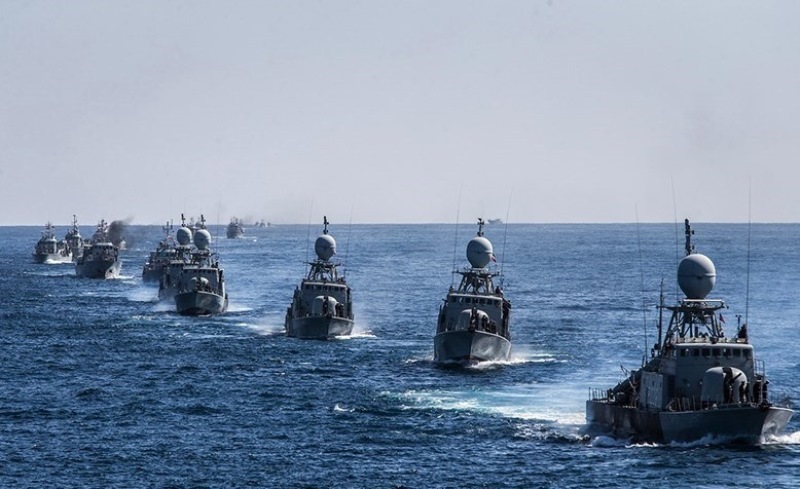
Iranian Navy
One of the Iranian "destroyers" - "Jamaran" - launches the anti-ship missile "Noor" during the exercises. IRIN is also trying to work "abroad". In April of this year, she sent the 39th Flotilla, led by the Alvand frigate, to the Indian Ocean to participate in the celebration of India's Independence Day. At the same time, the 40th Flotilla was deployed to combat piracy in the Gulf of Aden. It consists of the logistics ship Tunb and the frigate Alborz.
Iran is still preparing for a full-scale war with the US. An important role in it should have been played by the navy, which developed in two directions - for conventional and asymmetric operations, in accordance with the doctrine of irregular combat adopted several years ago.
When the “father” of the Islamic Republic of Iran, Ayatollah Ruhollah Khomeini, died in 1989, the country changed its security policy, and hence its military doctrine. Offensive ambitions were abandoned in favor of a doctrine based on conventional deterrence. At present, the commitment to defense, which, according to official declarations, would be uncompromising, decisive and aimed at the destruction of every adversary (and therefore, in practice, predominantly American troops) is invariably emphasized. If anyone dares to invade Iran, they will be captured, punished and destroyed all the way to the borders of our country, Major General Jaja Rahim-Safavi, former commander of the Islamic Revolutionary Guard Corps (2012-1997), military adviser, said in 2007 Ali Khamenei (de facto leader of Iran). The military adds that Iran's current defense system provides a definite and effective deterrent capable of confronting a state with arrogant forces through a serious and destructive response. The rhetoric of the supreme leader is identical - we do not want and do not start a war, but if it breaks out, America will be humiliated.
An important role in the doctrine formulated in this way is played by the navy, which is specific to Iran, since it consists of two independent (often competing with each other) structures, which is the result of the existence of two armed forces in Iran. . The first is Artesz, i.e. classic military. The second is the Islamic Revolutionary Guard Corps, created after the overthrow of the Shah in 1979 and reporting directly to the supreme leader of Iran.
Artesz controls the Iranian Navy (IRIN) along with the Naval Aviation (IRINA), while the Islamic Revolutionary Guard Corps develops its own naval structures (IRGCN). In the past, IRIN was the dominant force, but in recent years, the IRGCN has been strengthened, and even separate operational zones have been created, and the Islamic Revolutionary Guard Corps has taken over the most important defensive tasks. Both structures have their own marines.
According to Iranian doctrine, the navy is the first line of defense to protect or blockade a very important area of the Persian Gulf. Thus, one can understand the words of the supreme leader, who in November 2010 referred to the fleet as "strategic forces." The second goal is a political tool - the fleet is supposed to be used to "show the flag" on the seas.
In recent years, Iran has initiated a number of naval operations, as well as ship calls to the ports of third countries, including Saudi Arabia, Sudan, China, Tanzania, Syria and India, which can be perceived - for example, in terms of rhetoric for domestic needs - as practical confirmation of Iranian power and undoubted importance in the world, as well as evidence that the attempt to encircle Iran and drive it into isolation was not successful, and the Iranians - as the supreme leader put it at a meeting with naval commanders in 2012 - "achieved success and overcame difficulties" . For its few partners, Iran shows itself to be a reliable and valuable partner. The navy played a similar role as a political and propaganda tool when, in 2011, the frigate Alvand and supplier Kharg entered the Mediterranean through the Suez Canal as part of the fight against Israel (it was the first such crossing since 1979) . The declaration of the same year on the planned dispatch of warships to South America should be perceived in the same political and propaganda vein.
The role of the political "transmitter" is easier to understand if we look at the words spoken by Kadmium in May 2013. Habibollah Sajari, commander of IRIN. Then he announced the readiness of the fleet to begin a presence in the Atlantic, Indian and Arctic Oceans, if such an order is given by the supreme leader (which, by the way, is emphasized by the one who actually controls the country's defense system): we have the opportunity to raise the flags of Iran in various regions, from the North Pole to the South Pole,” the officer, quoted by Iranian Press TV, said, adding, “also in line with the official line that we will never cross the maritime borders of other countries. and we will never allow anyone to disturb even one centimeter of our territorial waters. In September 2012, Sajjari, who argued that no threat would harm Iran, said that IRIN would balance the US presence in the region by sending a naval task force near US territorial waters over the next few years. These words and the statement itself are extremely important, as they signal a significant change - in the past, regular troops, including IRIN, were not used as a tool of foreign policy, but only as a military tool.

